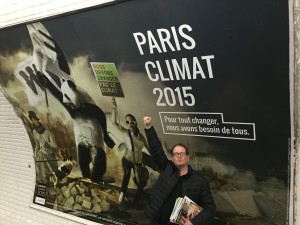By Dr. Adam Fenech
 I am in Paris this week for the climate conference seen as the last “do or die” chance at getting the world’s greenhouse gas emissions under control to limit the human increase in global average temperature to 2°C, above which is considered a “dangerous” level. Presently, 184 countries have submitted their intended plans for greenhouse gas reductions although, when totalled up, do not add up to resolve the issue. I have written earlier about some “magical” solutions to reduce the impacts of climate change that scientists call “geo-engineering solutions,” such as seeding the oceans with iron dust, but the discussions in Paris are focusing on ideas that are much more transformational for human society such as the concept of the “third industrial revolution” as proposed by author Jeremy Rifkin.
I am in Paris this week for the climate conference seen as the last “do or die” chance at getting the world’s greenhouse gas emissions under control to limit the human increase in global average temperature to 2°C, above which is considered a “dangerous” level. Presently, 184 countries have submitted their intended plans for greenhouse gas reductions although, when totalled up, do not add up to resolve the issue. I have written earlier about some “magical” solutions to reduce the impacts of climate change that scientists call “geo-engineering solutions,” such as seeding the oceans with iron dust, but the discussions in Paris are focusing on ideas that are much more transformational for human society such as the concept of the “third industrial revolution” as proposed by author Jeremy Rifkin.
To Rifkin, the price of energy and food is climbing, unemployment remains high, the housing market has tanked, consumer and government debt is soaring, and the economic recovery is slowing. Facing the prospect of a second collapse of the global economy, humanity is desperate for a sustainable economic game plan to take us into the future. The third industrial revolution beckons.
The third industrial revolution refers to an embracing of today’s new technologies to create thousands of businesses and millions of jobs that will impact the way we conduct business, govern society, educate our children, and engage in civic life. The five pillars of Rifkin’s third industrial revolution are shifting to renewable energy; transforming every building into green micro–power plants to collect renewable energies on-site; deploying storage technologies in every building to store intermittent energies; using Internet technology to transform the power grid into an energy internet that allows buildings to sell surplus green electricity back to the grid and share it with their neighbors; and transitioning our transport fleet of cars, trucks, trains, boats and airplanes to electric plug-in and fuel cell vehicles that can buy and sell green electricity on a smart, interactive power grid.
We all know about the first industrial revolution that began in Britain in the late 18th century with the mechanization of the textile industry. The revolution moved from hand production methods to machines, the increasing use of steam power, and, most importantly to climate change, a shift from wood and other bio-fuels to coal. The second industrial revolution came in the early 20th century, when Henry Ford mastered the moving assembly line and ushered in the age of mass production. The first two industrial revolutions made people richer and more urban. Rifkin identifies that a third industrial revolution is under way where a number of remarkable technologies are converging: clever software, novel materials, more dexterous robots, new processes (notably three-dimensional printing) and a whole range of web-based services.
The old way of making things involved taking lots of parts and screwing or welding them together. Now, even the Climate Lab at the University of Prince Edward Island owns a 3-dimensional printer. A product can be designed on a computer and “printed” on a 3D printer, which creates a solid object by building up successive layers of material. In time, these amazing machines may be able to make almost anything, anywhere.
Like all revolutions, this one will be disruptive. The revolution will affect not only how things are made, but also where, and by whom. Some companies will lose money but others will make money. Some people will lose jobs, but others will gain employment.
The Paris climate talks are discussing a living example of the third industrial revolution at Nord-Pas de Calais in France. Traditionally an industrial region, Nord-Pas de Calais has become a pioneer of tomorrow’s economy based on energy transition and digital technologies that have brought about behavioural change and a shift in the growth model towards a new carbon free economy. It started with millions of dollars of investments, lofty goals and a rallying call to “rev3” (or third industrial revolution) to begin projects for efficient energy in high schools; a zero carbon university; a rev3 hospital; industrial energy efficiency; smart electricity networks; new transport systems; and ecosystem service enhancements of their water catchment area. Its success has been linked to a unique shared governance model of the politicians, unions, businesses and the academic world along with the inclusion of civil society to bring about this change.
Some say they are dreamers, but the Paris climate talks have shown that they’re not the only ones.

